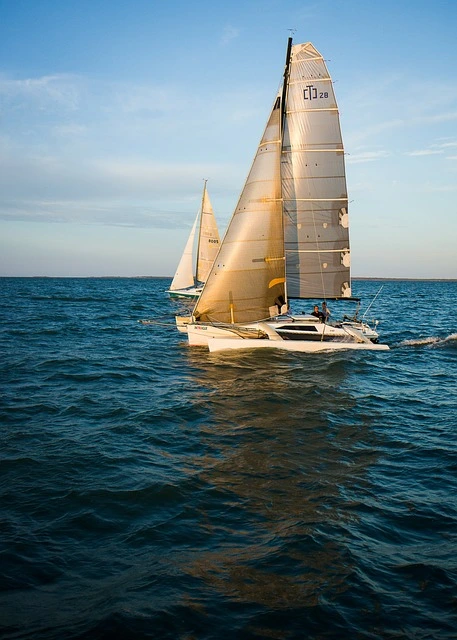A sailboat is a vessel powered by the wind, using sails to navigate. These vessels range in size from small dinghies to large cruising ships. Sailboats have been used for thousands of years for exploration, trade, and water entertainment.

A typical sailboat includes a hull, a mast, a main sail, and one or more secondary sails, also called foresails. The crew uses ropes called lines to adjust the sails and the boat's direction. Modern sailboats may also have auxiliary engines for navigating calm waters or for docking maneuvers.
Sailboats are used for various purposes, from sailboat races (regattas) to long-distance cruises. Some examples of sailboats include:
- Dinghies: Small and light sailboats for one or two people, used for learning to sail and for sailboat races.
- Cruising Sailboats: Larger sailboats designed for long ocean voyages, with sleeping cabins, kitchens, and bathrooms.
- Catamarans: Sailboats with two hulls, providing greater stability and speed on the water.
- Ketches: Sailboats with two masts, allowing for a greater variety of sails and increased navigational capability in different weather conditions.
- Schooners: Sailboats with multiple masts, used for luxury cruises and tourism on the water.
Sailboats can be an exciting and rewarding way to experience the sea and sailing, and they are very popular for sports and recreation on the water.
Here is an overview of the features and properties of sailboats:
- Hull Design:
Sailboats typically have a hull design optimized for sailing on the water. The hull can be monohull (single hull) or multihull (catamaran or trimaran).
- Sails:
Sailboats are equipped with sails that capture the wind's energy to propel the vessel forward. The number and type of sails can vary, including main sails, foresails, and special sails for specific conditions.
- Rigging:
Rigging includes the mast, boom, and various cables and ropes that control the position and shape of the sails. Rigging configurations can vary, such as sloop, cutter, ketch, or schooner.
- Keel or Centerboard:
Sailboats have a keel or centerboard to provide stability and prevent lateral drift. Keels can be fixed or retractable.
- Draft:
Draft is the distance from the waterline to the deepest point of the keel or centerboard. Reduced draft allows access to shallower waters.
- Cockpit:
The cockpit is the area where the crew operates the vessel. It includes the helm (wheel or tiller) and seats for crew members.
- Berths and Cabins:
Sailboats can have berths (sleeping areas) and cabins for overnight stays. Larger sailboats usually have more spacious accommodations.
- Mast Height:
Mast height determines the air draft of the sailboat, influencing its ability to pass under bridges and obstacles.
- Mast Configuration:
Sailboats can have different mast configurations, such as sloop, fractional rig, or schooner, influencing sail handling and performance.
- Rudder:
The rudder is a movable fin at the stern of the boat controlled by the helmsman, determining the sailboat's direction.
- Performance and Racing Features:
Some sailboats are designed for optimal performance and racing, with features like a tall mast, lightweight materials, and advanced sail shapes.
- Cruising Features:
Cruising sailboats prioritize comfort and amenities for extended stays on board, with spacious cabins, a kitchen, and navigation equipment.
Sailboats offer a unique and environmentally friendly way to navigate waters, harnessing the wind's energy for propulsion. Whether for regattas, cruises, or day trips, sailboats provide a wide variety of experiences for sailing enthusiasts.
